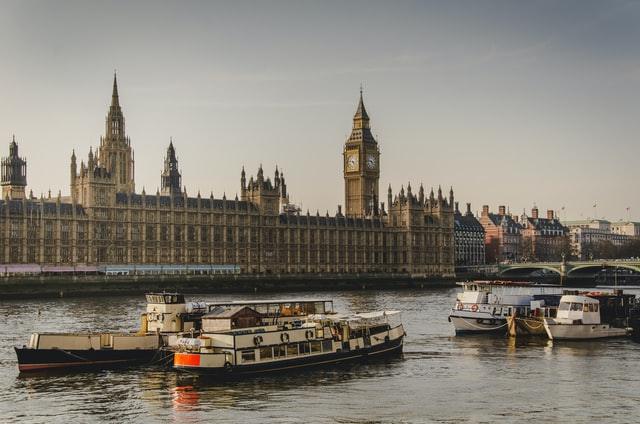Barges and Ferries
But what a thing here is, by way of a boat!
Persuasion
Until the middle of the 19th century the River Thames was a main thoroughfare of London. The nobility travelled the River in their own craft manned by their own liveried crew. A shallop is a fast oar-powered craft rowed by up to eight men that was popular on the Thames in the 15th, 16th, 17th and 18th Centuries. These Barges were the fastest means of water transport between business centres and residences and were the limousines of the lower Thames in the 17th and 18th century. An eight-oared Shallop could cover the 35 miles from Hampton Court to Greenwich in approximately four hours. During the Golden Age of oared craft, from the thirteenth century to the late nineteenth century, all rich families and official organisations, such as the Navy Board and the City merchants, possesed a Shallop.

Somerset House
Until the roads and carriages improved, most residences and major businesses were built alongside the Thames because of the safety and ease of transportation by boat. Evidence can still be seen today of the importance of travel by water in the magnificence of the stonework around the arched river entrance for Shallops to the Barge-Houses. At Somerset House in London the arched river entrance for Shallops to enter the Barge-House of the building can still be seen.

Lord Mayor's Ceremonial Barge, 1805
Shallops were sometimes called Tilt-boats, a tilt being a covered section or primitive cabin for sheltering passengers. The canopy of the Lord Mayor's State Barge is covered with blue cloth. Two different types of cloth were used for the awnings of ceremonial barges: blue cloth which was called "Plunkett", indicating a civic event; and "Murrey", a red cloth used on Royal occasions. One way to display wealth was to drape an expensive carpet over the vessel's Tilt. Rich and powerful men displayed their wealth and status by decorating their Shallop with gilded carvings. They also dressed their crew in splendid livery. The Sovereign, too, travelled on the Thames on an elaborately decorated state barge.
The earliest mention of a Royal Shallop was in 1214 when King John travelled to the signing of Magna Carta, near Runnymede on the Thames. Shallops were built in various sizes. The largest of the private shallops were eight oared, with six and four-oared versions being the smaller and slower vessels. In 1717 the Daily Courant reports that King George I was entertained during a progress on the Royal Barge from Whitehall to Chelsea by musicians playing Handel's "Water Music" from a City Company Barge that followed the Royal Barge. "His Majesty liked [the music] so well, that he caused it to be plaid over three times in going and returning." The post of Royal Bargemaster survives today, attending the Sovereign in ceremonial processions such as the State Opening of Parliament. Barges belonging to the City Companies always accompanied the Royal procession. There are historic state barges still in existence at the National Maritime Museum in Greenwich. They are the survivors of the Golden Age of Thames river travel. Some of the museum exhibits are:
- The Queen's Shallop built in 1689 byWilliam III for his wife Mary II. It is about 41 ft long and 6 ft in beam with beautifully carved and decorated adornments. It is the oldest barge in the collection. The shallop is simpler in design than other State barges because it was used as a harbour launch to carry the royal family to the royal yacht.
- William III's barge from 1691.
- Queen Anne'sbarge from 1710.
- Prince Frederick's barge, built in 1732 for Frederick, Prince of Wales,son of George II. William Kent Designed the exquisitely gilded royal barge.
The most notable of the public barge services was the Long Ferry which plied the waters between Gravesend and Billingsgate. The Gravesend, or Long Ferry, left twice-daily on the turn of the tide from The Pool of London. The Pool of London is the historic port of London situated between London Bridge and a short distance downstream from Tower Bridge. Since Roman times it had been an important dock area, the larder of London. The ferry was a larger open vessel capable of carrying as many as twenty passengers and even a little cargo if necessary. Gravesend, the port at the mouth of the Thames estuary, was the point of debarkation for passengers and goods on ships sailing up the Thames after an ocean voyage. There passengers and cargo were transferred to smaller boats for the trip up the Thames to Billingsgate.
Billingsgate, with its great fish market, was the wharf where travelers and goods were unloaded from the barges coming upriver from Gravesend. During the seventeenth century the old open barges were replaced by tilt-boats so that passengers could travel in greater comfort. The Long Ferry, if full, allowed a Shallop to take the excess passengers. Besides the Long ferry, 'great boats' were available twice-weekly at Queenhythe for Kingston, Windsor and other upriver destinations, while the Reading boat called weekly at Bull Wharf near Queenhythe. These ferrieshad designated routes and termini. In less busy areas, a bargemaster would wait until he had enough passengers to make a journey profitable. Some of the most popular Ferry locations were Gravesend ferry, Greenwich ferry, Eirth ferry, Limehouse ferry, Queenhythe ferry, Reading ferry, Woolwich ferry.
Written by Sharon Wagoner, Curator of The Georgian Index.



Leave a comment
This site is protected by hCaptcha and the hCaptcha Privacy Policy and Terms of Service apply.